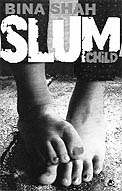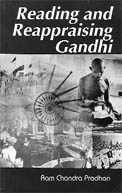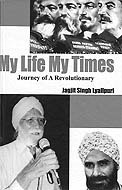|
Short Takes
Slum child and the Mahatma
Reviewed by Randeep Wadehra
Slum Child
by Bina Shah
Tranquebar. Pages: 288. Rs. 295
 There
is no dearth of great stories revolving around a young protagonist’s
attempts at escaping from oppressive environs and poverty. Charles
Dickens’ Oliver Twist is a classic template for this genre,
not to forget his Great Expectations. This journey from poverty
to comfort or relative luxury has fascinated writers and readers
alike. In the subcontinental context, the movie Slumdog Millionaire
has proved to be an immensely popular narrative featuring slum-child
Jamal’s successful but perilous escape from poverty. Similar is the
mix of dark and luminescent shades in Bina Shah’s gripping novel
featuring child-woman, Laila, as protagonist, who lives in Issa
Colony, a Christian majority slum in Karachi. Laila’s mother, Zainab,
works as a maid in the house of the Ansaris located in the posh
Defence Colony. Zainab’s first husband walks out on her when she
gives birth to the second daughter, Laila; her first daughter, Jumana,
is stricken with tuberculosis. Zainab begets three sons through her
second husband Irfan. There
is no dearth of great stories revolving around a young protagonist’s
attempts at escaping from oppressive environs and poverty. Charles
Dickens’ Oliver Twist is a classic template for this genre,
not to forget his Great Expectations. This journey from poverty
to comfort or relative luxury has fascinated writers and readers
alike. In the subcontinental context, the movie Slumdog Millionaire
has proved to be an immensely popular narrative featuring slum-child
Jamal’s successful but perilous escape from poverty. Similar is the
mix of dark and luminescent shades in Bina Shah’s gripping novel
featuring child-woman, Laila, as protagonist, who lives in Issa
Colony, a Christian majority slum in Karachi. Laila’s mother, Zainab,
works as a maid in the house of the Ansaris located in the posh
Defence Colony. Zainab’s first husband walks out on her when she
gives birth to the second daughter, Laila; her first daughter, Jumana,
is stricken with tuberculosis. Zainab begets three sons through her
second husband Irfan.
Laila’s world crumbles
when her sister dies and mother loses her sanity. When she discovers
that Irfan was planning to push her into prostitution she runs away.
She gets unexpected help from a reformed drug addict and a young
Pathan in reaching the Ansaris’ house. They provide her with
financial security but new problems crop up.
This story of a young
Pakistani Christian girl provides us with glimpses of the state of
minorities in general and Christians in particular in the highly
stratified and Islamised Pakistani society. But, in that forest of
prejudices and humiliations, Laila meets kind and helpful people like
Ansari "Madam," too. Shah has handled her characters quite
skillfully – not allowing mawkishness to creep into sensitive
situations. The storyline remains poignantly matter of fact and keeps
one engrossed. This novel has all the makings of a classic in the
subcontinent’s literature.
Reading and
Reappraising Gandhi
by Ram Chandra Pradhan
Macmillan. Pages: xiv+290. Rs. 210
 From
being a flesh-and-blood reality, Mahatma Gandhi has gradually acquired
all trappings of a mythological icon. Not his doing, of course. Yet,
his thoughts and actions have been undergoing constant analyses by
various scholars; and ordinary folks, too. Was he a moralist-idealist
or a pragmatist; a visionary statesman or a street-savvy politician?
There is any number of people who worshipfully put him on the pedestal
and deify him. But there are others who rail against him – pointing
out various failings, both in his personal and public realms. However,
with passage of time – as new social, political as well as economic
contexts arise – the need to reinterpret the Mahatma becomes
pertinent. As a result, a rich corpus of analytical writings on the
Mahatma has come into existence. This volume takes a comprehensive
look at the various writings on (some of them quite recent) and by the
Mahatma. This book would be quite useful for ordinary readers as well
as students of Gandhian studies. From
being a flesh-and-blood reality, Mahatma Gandhi has gradually acquired
all trappings of a mythological icon. Not his doing, of course. Yet,
his thoughts and actions have been undergoing constant analyses by
various scholars; and ordinary folks, too. Was he a moralist-idealist
or a pragmatist; a visionary statesman or a street-savvy politician?
There is any number of people who worshipfully put him on the pedestal
and deify him. But there are others who rail against him – pointing
out various failings, both in his personal and public realms. However,
with passage of time – as new social, political as well as economic
contexts arise – the need to reinterpret the Mahatma becomes
pertinent. As a result, a rich corpus of analytical writings on the
Mahatma has come into existence. This volume takes a comprehensive
look at the various writings on (some of them quite recent) and by the
Mahatma. This book would be quite useful for ordinary readers as well
as students of Gandhian studies.
My Life My Times
by Jagjit Singh Lyallpuri
Unistar. Pages: 270. Rs. 300
 The
Indian subcontinent’s political story is so vast and complex that
often some of its very interesting subtexts get ignored. We are aware
of the main story of the struggle for Independence launched by the
Congress party under the leadership of Mahatma Gandhi. The roles
played by other political entities like the Muslim League, the Singh
Sabha, Hindu Mahasabha, Communists, Akalis etc, have been well-
documented. The
Indian subcontinent’s political story is so vast and complex that
often some of its very interesting subtexts get ignored. We are aware
of the main story of the struggle for Independence launched by the
Congress party under the leadership of Mahatma Gandhi. The roles
played by other political entities like the Muslim League, the Singh
Sabha, Hindu Mahasabha, Communists, Akalis etc, have been well-
documented.
Yet, new additions to
the narrative keep happening, as evidenced by this interesting volume.
Jagjit Singh Lyallpuri dwells upon the various events that took place
before and after India’s Independence, the Communist movement’s
rise and its subsequent weakening due to splits, the Akali politics
etc, providing valuable literature for students of Punjab’s
politics, along with its national context.
|